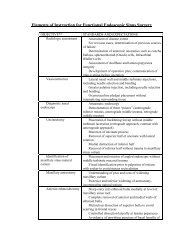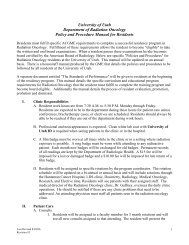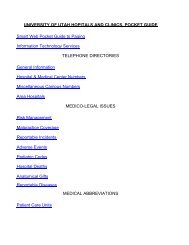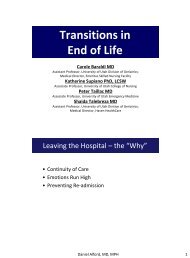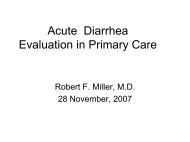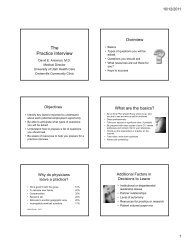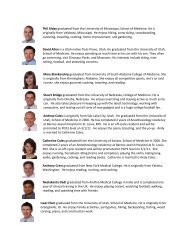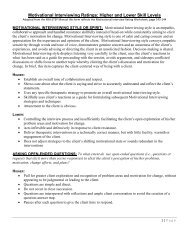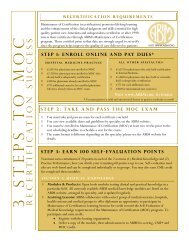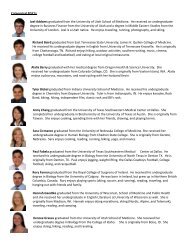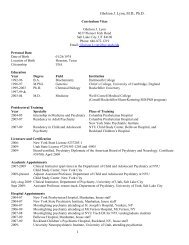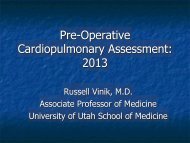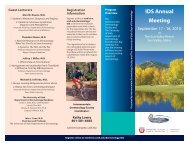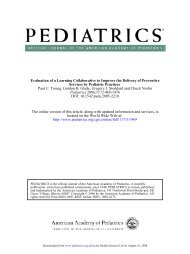Slides - University of Utah - School of Medicine
Slides - University of Utah - School of Medicine
Slides - University of Utah - School of Medicine
You also want an ePaper? Increase the reach of your titles
YUMPU automatically turns print PDFs into web optimized ePapers that Google loves.
Enteral Feeeding Update: 2013<br />
John Fang M.D.<br />
Pr<strong>of</strong>essor <strong>of</strong> <strong>Medicine</strong><br />
<strong>University</strong> <strong>of</strong> <strong>Utah</strong> Health Sciences Center
Objectives<br />
•! Understand the different enteral feeding<br />
options<br />
•! Know the benefits and limitations <strong>of</strong> enteral<br />
feeding<br />
•! Be aware <strong>of</strong> the complications <strong>of</strong> enteral<br />
feeding
Enteral Nutrition<br />
Nutrition Support Therapy<br />
•! Supplemental nutrition to enhance patients survival<br />
•! People that cannot eat any or enough food due to<br />
illness<br />
–! Long-term feeding in a patient who is unable to eat or<br />
swallow<br />
•! A portion <strong>of</strong> the stomach or bowel may not be<br />
working correctly<br />
–! A patient may have gone through surgery to remove parts<br />
<strong>of</strong> the GI system<br />
–! Distal intestinal tract is functional
Enteral Nutrition<br />
Tube Selection Criteria<br />
•! Length <strong>of</strong> Time supplemental nutrition is needed<br />
•! Surgical Patient or Non-Surgical Patient<br />
•! Risk <strong>of</strong> Aspiration
Enteral Nutrition<br />
Delivery Systems<br />
•! Nasoenteric Tubes<br />
–! Tube used is placed through the nose into the stomach or bowel<br />
–! nasogastric or nasoenteral feeding tubes<br />
–! 30 days <strong>of</strong> supplemental nutrition
Enteral Nutrition<br />
Feeding Methods<br />
–!Bolus Feeding<br />
•! Syringe or Gravity<br />
•! “Breakfast, Lunch, Dinner”<br />
–!Continuous Feeding<br />
•! “Pump”<br />
•! Feeding over a longer period <strong>of</strong> time (~24 hr)<br />
•! Slower rate <strong>of</strong> delivery
Enteral Feeding Tubes<br />
•! NET – Nasoenteric Tubes<br />
–! NG : Nasogastric<br />
–! Dobh<strong>of</strong>f : Nasoduodenal/nasojejunal<br />
•! PEG – Percutaneous Endoscopic<br />
Gastrostomy/Percutaneous gastrostomy<br />
•! Percutaneous GJ – Gastrostomy with<br />
Jejunal Extension Tube<br />
•! Percutaneous jejunostomy – Direct<br />
Jejunostomy
NET Techniques<br />
•! Bedside<br />
–! Blind, Low cost<br />
–! Post-pyloric position not mandatory<br />
–! Experienced personnel to place post-pyloric<br />
–! Requires radiographic confirmation<br />
•! Fluoroscopic<br />
–! Post-pyloric placement<br />
–! Requires C-arm and/or transport<br />
–! Radiation exposure<br />
–! Immediate confirmation<br />
•! Endoscopic
When<br />
•! When unable to use oral route for short term<br />
nutritional support (< 30 days)<br />
•! When not on vasopressors<br />
•! Within first 24 hours ABCD<br />
–!Airway<br />
–!Breathing<br />
–!Circulation<br />
–!Diet (Feed)<br />
Tech GI Endo 2001;3:9-15
Naso-gastric tubes<br />
•! More physiologic<br />
•! Formula<br />
–! isotonic, hypertonic<br />
–! Can use blenderized<br />
•! Infusion<br />
–! continuous, bolus<br />
•! Less reliable<br />
–! ICU gastroparesis<br />
30-70%<br />
NGT vs.NET<br />
Naso-enteric tubes<br />
•! Less physiologic<br />
•! Formula<br />
–! isotonic<br />
•! Infusion<br />
–! continuous, ! 100 cc/hr<br />
•! More reliable<br />
–! feed 1-2 days post-op
NET Outcomes:<br />
Complications<br />
•! Nasopharyngeal lesions<br />
•! Sinusitis<br />
•! Diarrhea<br />
•! Intestinal ischemia<br />
•! Metabolic<br />
DiSario, Fang et all. Gastrointest Endosc 2002;55(6)
NET Complications:<br />
•! Misplacement<br />
•! Aspiration<br />
Tube related<br />
–!Elevate HOB 30-45º<br />
•! Post placement complications<br />
–!Clogging<br />
–!Displacement<br />
–!Inadvertent tube removal<br />
•! Taping<br />
•! Suture/Staple<br />
•! Nasal Bridle
•! Inadvertent NET removal ~<br />
40%<br />
•! Nasal Bridle 1980<br />
•! “Nasal tube retention<br />
system”<br />
–! Magnet retrieval<br />
•! QI project Pitt<br />
–! 36%!10%<br />
–! Use would " 275 tubes, " 330<br />
Xrays, " 45 nurse days<br />
Nasal Bridle<br />
Gunn JPEN 2009;33:50-54
Percutaneous Gastrostomy:<br />
Indications and Contraindicatons<br />
Indications Contraindications<br />
•! Altered consciousness<br />
•! Oropharyngeal/esophageal<br />
CA<br />
•! Gastric decompression<br />
•! Neurological swallowing<br />
dysfunction<br />
•! Facial trauma<br />
•! Catabolic states<br />
–! Burns, HIV, CF<br />
•! Absolute<br />
–! Coagulation disorders<br />
•! Relative<br />
–! Poor survival<br />
–! Dementia<br />
–! Massive ascites<br />
–! Severe obesity<br />
–! Peritoneal dialysis/<br />
metastases<br />
–! Disease <strong>of</strong> gastric/abdominal<br />
wall
Initial Placement & Adjunct<br />
Procedures<br />
•! GI Endoscopic Procedures<br />
•! IR Radiographic Procedures<br />
•! OR Surgical Procedures<br />
–!Adjunct Procedure – Nissen Fundoplication
PEG Video
PEG Replacement
Complications <strong>of</strong> PEG<br />
!! Aspiration<br />
!! Infection<br />
!! Leakage<br />
!! Buried bumper syndrome<br />
!! Gastrocolic fistula<br />
!! Pneumoperitoneum<br />
!! Neoplastic seeding to abdominal wall<br />
!! Clogging<br />
!! Inadvertent removal
Buried Bumper Syndrome<br />
Too much tension!!!
Gastrocolic fistula<br />
•! Causes:<br />
–! puncture <strong>of</strong> colon at the time <strong>of</strong><br />
gastrostomy<br />
–! pinching <strong>of</strong> colon between the<br />
gastric and abdominal walls<br />
•! Usually becomes apparent after<br />
several weeks<br />
–! severe diarrhea following<br />
feedings<br />
•! In nearly all cases, the condition<br />
may be treated by removing the<br />
gastrostomy tube
Neoplastic seeding to skin
•! Motility<br />
J-Tube instead <strong>of</strong> PEG for:<br />
–!gastroparesis (diabetes – result & cause)<br />
•! Obstruction<br />
–!malignant, pancreatitis, surgical, etc<br />
•! Aspiration<br />
–!salivary/bronchial stimulation or reflux<br />
•! Reflux<br />
–!severe GERD, esophageal ulcers
Jejunal Feeding: Options<br />
•! Nasojejunal<br />
•! Gastrostomy with<br />
jejunal extension<br />
•!Single piece jejunal<br />
extension<br />
•! Direct<br />
Percutaneous<br />
Jejunostomy
Direct PEJ
EN Formula Selection<br />
• Initial decision – Candidate for Immune-modulating<br />
formula?<br />
–! Elective major GI surgery (esophageal, gastric, pancreatic)<br />
–! Trauma (ISS >18, ATI >20) - Including severe head injury<br />
–! Burns (TBSA > 30%)<br />
–! Head/neck cancer<br />
–! Critically ill on mechanical ventilation (caution-sepsis)<br />
•! Standard enteral formula (1 cal/cc) – if not<br />
candidate<br />
–! Possible malassimilation –<br />
–! Consider: Small peptide/MCT oil<br />
•! Specialty formulas rarely indicated<br />
1
What the #*!? Tube is this?<br />
a b<br />
c d
PEG<br />
Tube Types<br />
b d f h<br />
Replacement<br />
PEG<br />
PEGJ<br />
Low Pr<strong>of</strong>ile<br />
PEG
What the #*!? Ports are these?<br />
Medication/Jejunal Port<br />
Feeding/Jejunal Port<br />
Gastric/Decompression Port
Percutaneous Gastrostomy:<br />
Outcomes<br />
•! Procedure M+M<br />
–! Mortality
PEG in Dementia Myths<br />
•!PEG Dementia Facts:<br />
•!Eating is last ADL to be lost<br />
•!Dementia survival 12-18 mos<br />
•!Final phase <strong>of</strong> illness
PEG ethics<br />
•! Enteral feeding aims to improve nutritional status<br />
–! Improves mortality, LOS, complications<br />
–! Proven in post-CVA, H+N cancer<br />
–! Not proven in metastatic malignancy, dementia<br />
•! Nutrition support is no more essential or basic than<br />
any other form <strong>of</strong> medical therapy<br />
–! No obligation to <strong>of</strong>fer, recommend or perform intervention<br />
<strong>of</strong> no benefit<br />
–! Do not have to continue once started
PEG ethics con.<br />
•! What about hunger/thirst?<br />
–! majority <strong>of</strong> patients (up to 63%) never experience hunger or thirst<br />
–! If occur usually transient, relieved easily with minimal intake.<br />
•! Hand feeding important to social interaction<br />
–! touch, taste, nurturing, and the<br />
–! PEG’s may require physical restraints may lead to distress, agitation,<br />
and the need for sedation<br />
–! Hand feeding <strong>of</strong>ten difficult, time consuming<br />
•! QOL family, relatives, and caregivers improves with<br />
gastrostomy placement<br />
–! Unable to measure QOL in demented pt’s<br />
–! Some nursing homes require PEG
To PEG or not to PEG
Feeding Tube Goal<br />
before Fang after Fang



